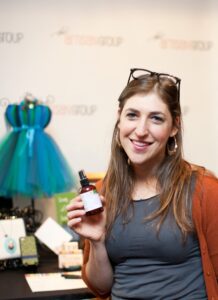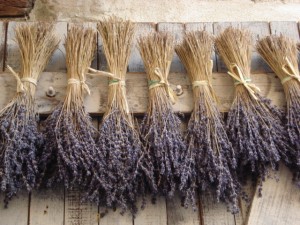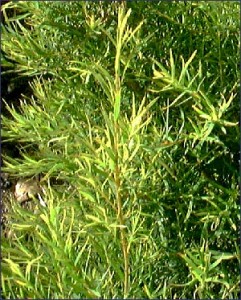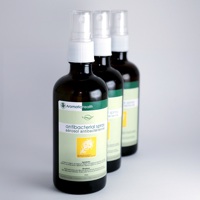This article is one I’ve been meaning to write for some time. Six years ago, my mother was diagnosed with colorectal cancer. In an effort to help her ease the discomforts she had to endure, I spent countless hours researching essential oils and hydrosols to learn how they can be used to aid the symptoms of various cancers. I used a number of essential oils and hydrosols topically and internally with my Mum, to help ease the side effects of chemotherapy and radiation, calm her stress and anxiety levels, and alleviate her insomnia and nausea. Four years after her death, I feel that I’m able and ready to share some of that knowledge.
Cancer will be the world’s number one cause of death by the end of 2010. It is estimated that $1 billion USD is donated to cancer research each year. As Jeffrey Yuen once said, ‘We finance cancer by the amount we dread it’. Now if that money were to be spent on cancer prevention, how different would that statistic be?
It now seems as though our air, soil and water are filled with toxins, but there are factors we can control. If we were to improve our diets, exercise regularly, reduce some of our UV exposure and read the labels on the products we use, specifically personal care products, then we can reduce our risk. The Environment Working Group (EWG)1 reports that the average person uses 9 personal care products per day, which contain 126 chemical ingredients. For 1 out of 4 women, that number is 15 or higher. Choosing natural products and paying attention to the ingredients in the products you purchase, is one way to decrease these statistics. If you are unsure whether an ingredient is safe, the EWG has a website which lists over 25,000 personal care products and their safety level.2
For most people, aromatherapy and essential oils do not usually come to mind as a complimentary treatment, when someone hears that they have cancer. The oils are very powerful though and their effects are surprising even to those who believe that conventional treatment is the only option. Essential oils and hydrosols can also aid with the emotional and psychological issues that arise when faced with a life threatening diseases, such as cancer. Aromatherapy is just one holistic modality, meaning that you treat the whole person, not just the disease. Essential oils and hydrosols, unlike conventional medications, are selected for the individual being treated, not as a one size fits all for general use.
It was once believed that any type of massage would promote cancer metastasis. Research now shows that massage can be very beneficial to those with cancer, specifically for managing pain and depression.3 The gentle massage used during an aromatherapy massage promotes relaxation and helps to eliminate toxins from the body. Even a simple hand massage can have a positive effect.4
The essential oils of grapefruit (citrus paradisii), orange (citrus senensis) and lemon (citrus limonum) contain D-limonene, which has shown to have anti-tumour properties5, chemotherapeutic activity and low toxicity.6 It is particularly beneficial for breast and colon cancer.7 Note that these citrus oils are phototoxic and should not be used topically on people with skin cancer. When possible, organic essential oils should be used. These citrus oils, as well as neroli essential oil, are also antidepressants and help with anxiety. The hydrosol of neroli can be used as a body, room or linen spray.

In addition to the citrus oils, other essential oils and hydrosols, which aid with side effects and killing of cancer cells include:
Ginger (zingiber officinalis) essential oil can be inhaled or taken internally in water, to ease nausea.8
The essential oil and hydrosol of frankincense (boswellia carteri) has shown anticancer, antimicrobial and antioxidative activity.9 & 11 Frankincense can also distinguish the difference between normal and cancerous cells and suppress cancer cell viability.10
Sweet fern (comptonia peregrina) and sweet gale (myrica gale) hydrosols can be combined and used topically as a compress or diluted in water and drank throughout the day. Both plants have shown to be cytotoxic (toxic to cells) against human lung and colon cancer cell lines. 12 & 13
Greenland moss, aka Labrador Tea (ledum greonlandicum) is one of the most powerful therapeutic hydrosols and only needs to be about 10% of the blend to be effective.14 It is currently in experimental stages for use with liver cancer and has shown anticancer activity against malignant lung and colon tumours.15 Marsh Labrador Tea has also been shown to protect against gamma radiation.
The hydrosol of niaouli (melaleuca quinquinervia CT viridiflorol) can be used if you are undergoing radiation treatmentto help to prevent burns and protect the skin.14
Vitamin D also plays an important part in our health. There have been numerous studies which show that vitamin D supplementation aids with cardiovascular disease, musculoskeletal health, autoimmunity and cancer. A study release this month showed that a vitamin D deficiency enhances the growth of tumours.
My main focus has been on the essential oils and hydrosols I had used with my mother, to ease her symptoms. There is also research available on the use of essential oils and hydrosols for bladder, breast, liver, lung, prostate and skin cancers and the treatment of malodorous ulcers. Essential oils and hydrosols are currently being reviewed at Princess Margaret Hospital in Toronto, by Dr. Claire Edmonds and Dr. Alastair Cunningham, in coping with a cancer diagnosis.
I am not claiming that essential oils and hydrosols will cure cancer, but they will aid with the side effects of chemotherapy and radiation and have shown to kill cancer cells. Throughout the majority of my mother’s treatments, while she was taking the citrus and ginger essential oils, and Greenland moss and sweet gale hydrosols, she was still able to enjoy life. She was able to go salsa dancing which was a passion of hers. She felt free while dancing, and no one could tell she was ill. I believe this speaks volumes for how much the essential oils and hydrosols helped her to overcome the side effects of her chemotherapy and radiation treatments.
Michelle Reynolds, CAHP
__________________________________________________________________
1. Environmental Working Group: http://www.EWG.org
2. Skin Deep – Cosmetic Database: http://www.cosmeticsdatabase.com
3. A Review on the Effects of Aromatherapy for Patients with Depressive Symptoms. Yim VW, Ng AK, Tsang HW, Leung AY. J Altern Complement Med. 2009 Feb 13. PMID: 19216657
4. Effects of aroma handmassage on pain, state anxiety and depression in hospice patients with terminal cancer. Chang SY. Taehan Kanho Hakhoe Chi. 2008 Aug;38(4):493-502. PMID: 18753801
5. Identification and characterization of limonene metabolites in patients with advanced cancer by liquid chromatography/mass spectrometry. Poon GK, Vigushin D, Griggs LJ, Rowlands MG, Coombes RC, Jarman M. Drug Metab Dispos. 1996 May;24(5):565-71. PMID: 8723738
6. Phase I and pharmacokinetic study of D-limonene inpatients with advanced cancer. Cancer Research Campaign Phase I/II Clinical Trials Committee. Vigushin DM, Poon GK, Boddy A, English J, Halbert GW, Pagonis C, Jarman M, Coombes RC. Cancer Chemother Pharmacol. 1998;42(2):111-7. PMID: 9654110
7. Medical Aromatherapy, Healing with Essential Oils. Kurt Schnaubelt, M.D.
8. A Phase II/III Randomized, Placebo-Controlled, Double-Blind Clinical Trial of Ginger (Zingiber officinale) for Nausea Caused by Chemotherapy for Cancer: A Currently Accruing URCC CCOP Cancer Control Study. Hickok JT, Roscoe JA, Morrow GR, Ryan JL. Support Cancer Ther. 2007 Sep 1;4(4):247-50. PMID: 18632524
9. Studies of the in vitro anticancer, antimicrobial and antioxidant potentials of selected Yemeni medicinal plants from the island Soqotra. Mothana RA, Lindequist U, Gruenert R, Bednarski PJ. BMC Complement Altern Med. 2009 Mar 25;9:7. PMID: 19320966
10. Frankincense oil derived from Boswellia carteri induces tumor cell specific cytotoxicity. Frank MB, Yang Q, Osban J, Azzarello JT, Saban MR, Saban R, Ashley RA, Welter JC, Fung KM, Lin HK. BMC Complement Altern Med. 2009 Mar 18;9:6. PMID: 19296830
11. LY294002 enhances boswellic acid-induced apoptosis in colon cancer cells. Liu JJ, Duan RD. Anticancer Res. 2009 Aug;29(8):2987-91. PMID: 19661305
12. Composition and cytotoxic activity of the leaf essential oil of Comptonia peregrina (L.) Coulter. Sylvestre M, Pichette A, Lavoie S, Longtin A, Legault J. Phytother Res. 2007 Jun;21(6):536-40. PMID: 17326040
13. Chemical composition and anticancer activity of leaf essential oil of Myrica gale L. Sylvestre M, Legault J, Dufour D, Pichette A. Phytomedicine. 2005 Apr;12(4):299-304. PMID: 15898708
14. Hydrosols: The Next Aromatherapy. Suzanne Catty. Healing Arts Press, 2001.
15. Antioxidant, anti-inflammatory and anticancer activities of methanolic extracts from Ledum groenlandicum Retzius. Dufour D, Pichette A, Mshvildadze V, Bradette-Hébert ME, Lavoie S, Longtin A, Laprise C, Legault J. Phytomedicine. 2005 Apr;12(4):299-304. PMID: 15898708











